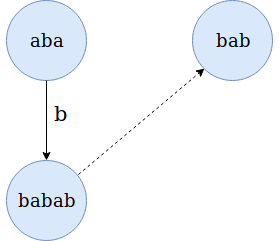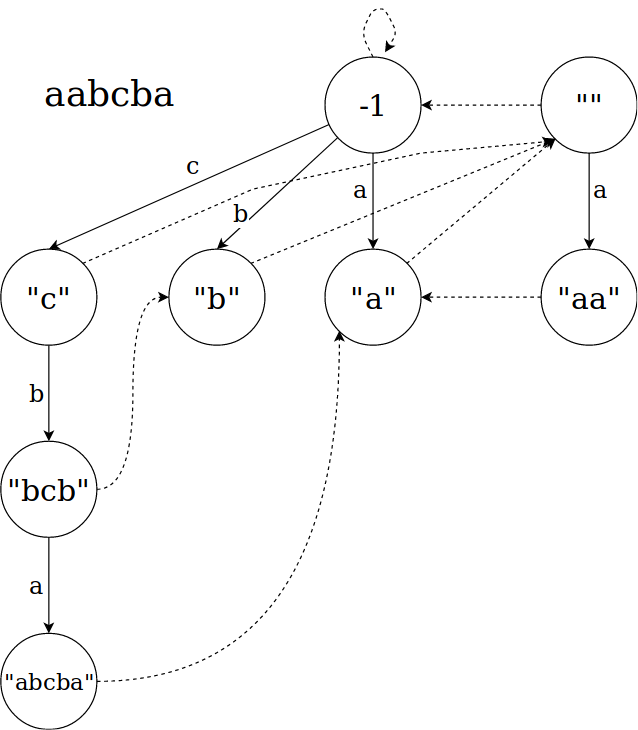
Open-Source Internship opportunity by OpenGenus for programmers. Apply now.
Reading time: 30 minutes | Coding time: 15 minutes
Palindromic tree (Eertree) is a tree based data structure that is specifically used to tackle problems involving palindromes of a string and its substrings. It can solve problems like 'longest palindrome in a string', 'count of plaindromic substrings' etc.
A palindromic tree keeps track of all palindromic substrings of a string in linear time and space. The actual structure of palindromic tree is that of a directed graph rather than a tree. The nodes of a palindromic tree store palindromic substrings.
There are 2 types of edges:
- Labeled edges: This is a directed edge that faces downwards. It has some character as its label. A lebeled edge with label a from node u to node v means that node v can be obtained by adding a as a prefix and suffix to substring of u. This makes it possible to obtaing a palindromic substring by traversing down from empty string node.

- Suffix edges: These edges points to the node that represents longest proper suffix of the node that is also a palindrome. Every node has exactly one such edge.
Palindromic tree actually has 2 roots:
-
first root represents a string of length -1, i.e. an imaginary string. Following a labeled edge from this root adds only the single character that is in label. For example, following the edge with label a from this root will give the string 'a'.
-
Second root is a string with length 0, i.e. an empty string. Labeled edge performs normally on this node.
Since a string of length N can have maximum N palindromic substrings, it is guranteed that max nodes in the tree will be N + 2, after including the roots. Max suffix edges will be N, one for every node.
Algorithm
Initializing the tree
- Initializing the tree:
- Initialize the tree by creating the two roots. Call the root with -1 string length as root1 and root with length 0 as root2. The suffix edge of root1 will point to itself and suffix edge of root2 will point to root1.
Inserting in the tree
- Inserting in the tree:
- A recursive definition is used to define insertions into the tree. Assume that palindromes of a string S with length l is to be stored in the tree and everything has been stored till an index x. Inserting the character at position x+1 means that a new node will be inserted that will representing longest palindromic substring ending at x+1. So to do that, we need to find the longest substring s which was added on insertion of S[x].
- Since the suffix edges have also been stored until now, they can be traversed to get to the nodes with all possible candidates for string s efficiently. Start from previously inserted node and keep traversing up through the suffix edges until suitable node is reached. Call this node which stores s as X. Add a labeled edge from X to a new node that stores the string S[x+1]sS[x+1], call it X'.
- Now we need to add a suffix edge for node X'. To do that, traverse up from node X through the suffix edges till a node is reached that forms a palindrome after adding S[x+1]. The nodes with length 1 will point to root2.
The palindromic substring count problem can be solved just by counting the nodes in the tree. The code can be modified to keep a counter.
Any other problems like counting some sub-palindrome's occourances can be done by simply traversing the tree.
A eertree for the string "aabcba" will look like:

Complexity
- Time complexity:
- Build: O(N)
- Insert: O(N)
- Search: O(N)
- Space complexity: O(N)
Where N is the length of string.
Implementation
C++ 11
/*
* c++ 11 code to construct an EerTree tree. The method printAll
* will print all strings stored in the tree.
*/
#include <iostream>
#include <vector>
#include <string>
struct Node{
int start, end;
int len;
Node *suffix;
std::vector<Node *> labeled;
Node(){
start = end = len = -1;
suffix = nullptr;
labeled.assign(26, nullptr);
}
};
class EerTree{
private:
Node *root1;
Node *root2;
Node *current;
public:
EerTree(){
root1 = new Node();
root1->len = -1;
root1->suffix = root1;
root2 = new Node();
root2->len = 0;
root2->suffix = root1;
current = root2;
}
int insert(std::string &s, int pos){
Node *cur = current;
int letter = s[pos] - 'a';
while(true){
// loop is guranteed to break at root1
if (pos - 1 - cur->len >= 0 && s[pos - 1 - cur->len] == s[pos])
break;
cur = cur->suffix;
}
Node *temp = new Node();
temp->len = cur->len + 2;
temp->end = pos;
temp->start = pos - temp->len + 1;
cur->labeled[letter] = temp;
if (temp->len == 1){
// if cur is root1
temp->suffix = root2;
current = temp;
return 0;
}
// find the suffix node
while (true) {
cur = cur->suffix;
if((pos - 1 - cur->len) >= 0 && s[pos - 1 - cur->len] == s[pos]) {
temp->suffix = cur->labeled[letter];
break;
}
}
current = temp;
return 0;
}
void print(std::string &s, Node *node){
if(node != root1 || node != root2){
for(int i = node->start; i <= node->end; ++i)
std::cout << s[i];
std::cout << '\n';
}
for(int i = 0; i < 26; ++i){
if(node->labeled[i] != nullptr){
print(s, node->labeled[i]);
}
}
}
void printAll(std::string &s){
print(s, root1);
print(s, root2);
}
};
int main() {
std::string s = "aabcba";
EerTree tree;
for(int i = 0; i < s.size(); ++i)
tree.insert(s, i);
std::cout << "insertion done\n";
tree.printAll(s);
}Applications
- Palindromic tree is used to store all palindromic substrings in a string.
- Palindromic tree can be used to count new palindromic subtrees after insertion in efficiently.
- It can be used to solve factorization problem in O(kn) time (arxiv 1506.04862 chapter 4).
References/ Further reading
- Original paper on Eertree : arxiv 1506.04862.
- Codeforce blogpost by adamant.
